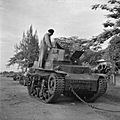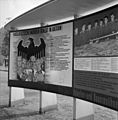Aftermath of World War II facts for kids
The countries involved in World War II saw huge changes after the war ended. Much of Europe was left in ruins and divided. The Marshall Plan helped rebuild Western Europe. Meanwhile, the Soviet Union took control of many countries in Central and Eastern Europe. Germany was split into two parts. Japan and Korea were occupied by the United States and the Soviet Union. Also, the United Nations was created to help keep peace around the world.
Contents
- Europe Divided After the War
- Germany and Austria Under Occupation
- Japan and Korea Under Occupation
- Changes in China
- New Borders and Forced Moves
- Paying for Damages (Reparations)
- The United Nations is Formed
- Two New Superpowers
- Quick Facts About What Happened After World War II
- Images for kids
- See also
Europe Divided After the War
After World War II, a lot of Europe was destroyed. Millions of people had no homes, and the economy was a mess. Europe became divided into two main areas.
- The Western Bloc included Western Europe and Japan. The United States led and helped these countries.
- The Eastern Bloc included Central and Eastern Europe. The Soviet Union led this area. It soon became known as being behind the "Iron Curtain."
In 1947, the U.S. Secretary of State George Marshall started the "European Recovery Program." This was better known as the Marshall Plan. From 1948 to 1952, the United States gave 13 billion dollars. This money helped rebuild Western Europe.
The Soviet Union took control of much of Central and Eastern Europe. They also controlled the Balkans. The Soviets helped communist governments take power in almost all these countries. They also added Estonia, Latvia, and Lithuania to their control.
Germany and Austria Under Occupation
Leaders met at the Yalta and Potsdam meetings. They decided what to do with Germany. Germany was split into four zones. The American, British, and French zones joined together in 1949. They formed the Federal Republic of Germany (West Germany). The Soviet zone became the German Democratic Republic (East Germany).
Austria was also separated from Germany. It was divided into four sections. In 1955, these four sections reunited. Austria became the Republic of Austria.
Japan and Korea Under Occupation
Japan was occupied by the U.S. after the war. Some British troops also helped. This lasted until a peace treaty in 1952. The Americans focused on three main goals in Japan:
- Making sure Japan no longer had a strong military.
- Destroying Japan's weapons factories.
- Setting up a democratic government with a new constitution.
The islands of Sakhalin were taken by the Soviet Union. They became part of the Soviet Union.
Korea was divided into two parts by the Soviet Union and the U.S. This led to two separate governments in 1948.
- The northern part of Korea became the Democratic People's Republic of Korea.
- The southern part of Korea was supported by the U.S. It became an anti-communist country called the Republic of Korea.
These two governments fought in the Korean War from 1950 to 1953. They are still divided today.
Changes in China
World War II was a very important time for China. Before the war against Japan, China had been controlled by different powerful countries. It was not very strong. China's president, Chiang Kai-shek, worked to build up the country. The Republic of China became one of the first members of the United Nations. It also got a permanent spot on the Security Council.
However, in 1949, the Chinese communists won the civil war. They fought against the Kuomintang (the main political party). The communists started the People's Republic of China on the mainland. The Kuomintang leaders went to Taiwan. Chiang Kai-shek ruled there until he died.
New Borders and Forced Moves
After the war, new borders were drawn for many countries. Millions of people found themselves living in areas that were now part of a different country. They were often forced to leave their homes. It is thought that between one and two million people died because they were forced to move.
Paying for Damages (Reparations)
Reparations mean paying or helping someone you have harmed. Germany was ordered to pay reparations to the United Kingdom, France, and the Soviet Union. The United States took German inventions (patents) and German-owned property in the U.S.
Italy, Romania, Hungary, Bulgaria, and Finland also had to pay reparations. But they were allowed to become independent countries again. They could also join the United Nations.
The United Nations is Formed
The United Nations was created in 1945. Its main goals are to keep world peace and improve living conditions for people everywhere. When it started, 51 countries joined. Today, the United Nations has 193 member countries.
Two New Superpowers
After the war, the United States and the Union of Soviet Socialist Republics (USSR) became the two most powerful nations. Even though they had been allies during the war, they became rivals afterward.
The United States had used two atomic bombs in 1945. The USSR developed its own atomic weapon in 1949. This led to an "arms race." Both countries tried to build more powerful weapons and better technology than the other. This power struggle led to the Cold War. The Cold War never became a "hot" war (a direct fight) because both the Soviet Union and the United States had powerful weapons. They knew that if they used them, both sides would be destroyed.
Quick Facts About What Happened After World War II
- Europe was divided into two main parts:
- The Western Bloc included Western Europe and Japan. The United States helped these countries.
- The Eastern Bloc included Central and Eastern Europe and the Balkans. The Soviets helped communist governments take power in many of these countries.
- Germany was split into East Germany (German Democratic Republic) and West Germany (Federal Republic of Germany).
- Japan was occupied by the U.S. The Soviet Union took control of the Sakhalin islands.
- Korea was divided into two parts: North and South Korea.
- Millions of people had to leave their homes. This happened because country borders were changed after the war.
- Several countries had to pay reparations (money or help for damages) to countries harmed during the war.
- The United Nations was formed in 1945 to promote peace.
- The world saw two new superpowers rise: the USA and the USSR. They competed for power in weapons and technology.
Images for kids
-
The Trust Territory of the Pacific Islands in Micronesia. The United States managed this area from 1947 to 1986.
-
Germans being forced to leave the Sudetenland.
-
The "Big Three" at the Yalta Conference: Winston Churchill, Franklin D. Roosevelt, and Joseph Stalin. Their countries' relationships changed a lot after World War II.
-
Generalissimo Chiang Kai-shek, leader of the Chinese nationalist Kuomintang.
-
French soldiers captured at Điện Biên Phủ, escorted by Vietnamese troops, 1954.
-
An Indian soldier looking at a light tank used by Indonesian nationalists. British forces captured it during fighting in Surabaya.
-
A V-2 rocket launching at Peenemünde, Germany, in 1943.
-
Japanese soldier Hiroo Onoda giving his military sword to Philippine President Ferdinand Marcos when he surrendered on March 11, 1974.
See also
 In Spanish: Posguerra de la Segunda Guerra Mundial para niños
In Spanish: Posguerra de la Segunda Guerra Mundial para niños
















